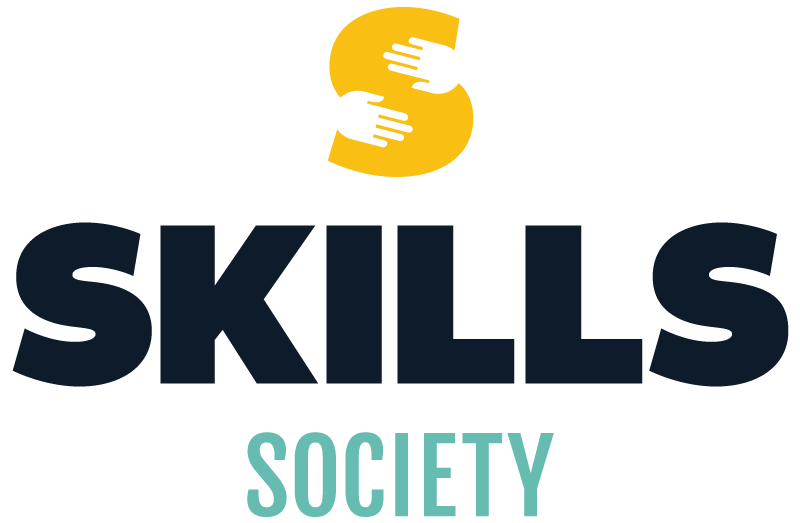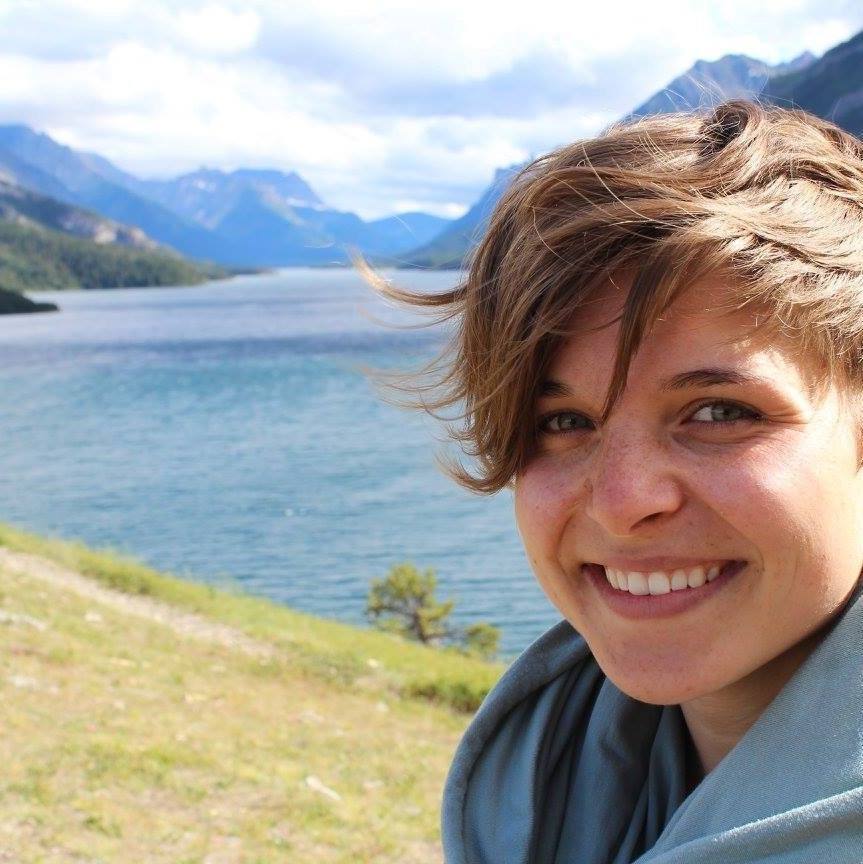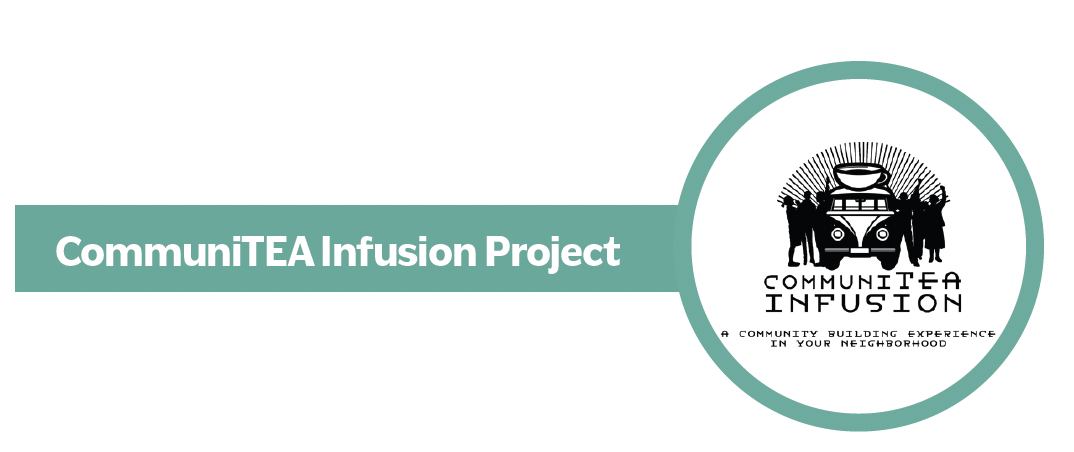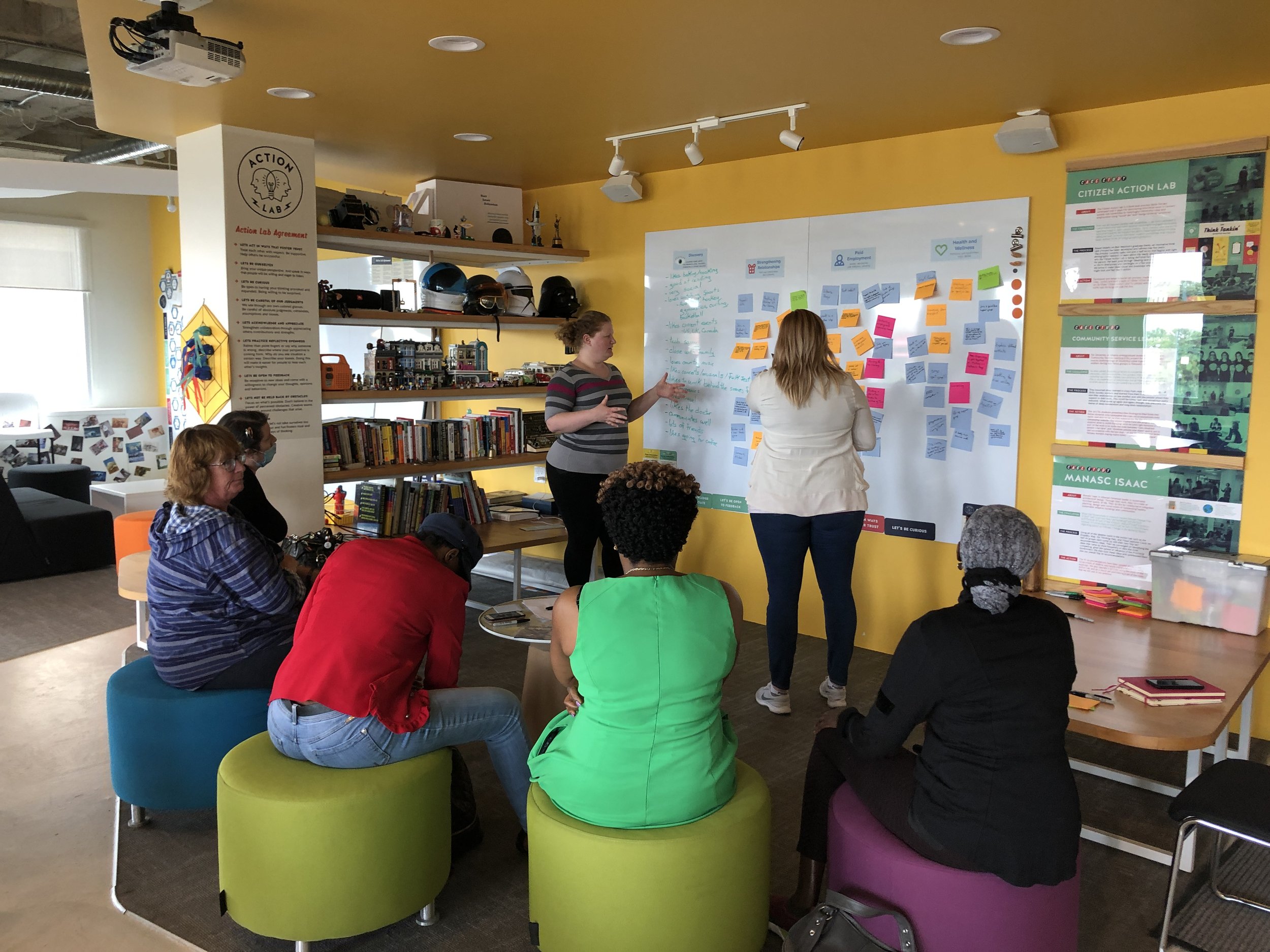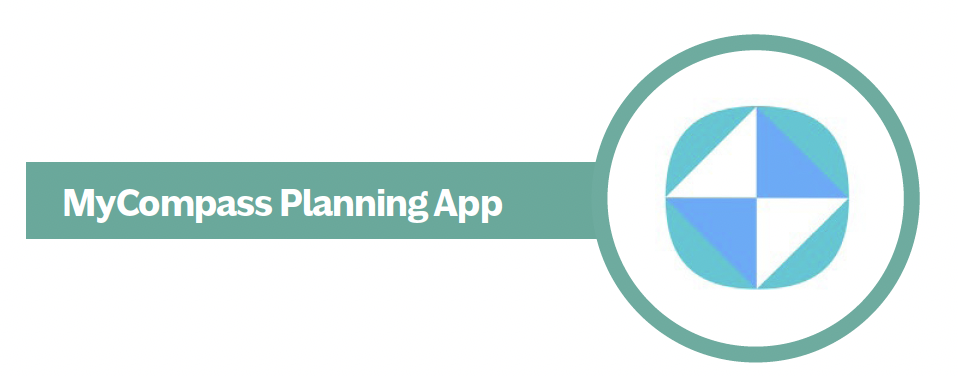Reflections on the 'Good Life' 2022 AGM Report
Paige Reeves, Senior Leader of Research & Social Innovation
Rebecca Rubuliak, Senior Leader of Continuous Improvement & Innovation
Hopes for this article
In writing this piece we grappled with a tricky tension - trying to strike a balance between sharing big and lofty ideas and offering practical examples and tangible ways those ideas show up in all our everyday lives. This is a tension we are continuously exploring as we strive to honour our commitment to bridging the gap between ‘theory’ and ‘practice’. While we believe creating space for exploring big ideas, dreaming, and imagining new possibilities is important work, we also recognize many in our Skills community are looking to us for ways to make life better in the here and now. Here we try to offer a bit of both. Reading this article we hope it might make space for you to:
Pause and think
Shake some assumptions loose
Learn something new
Reflect on the way you currently do things and see some new practices you might incorporate moving forward
Come away with more curiosity to explore further what the ‘good life’ means
Who defines the ‘good life’?
“What does it mean to define…the good life for [people with disabilities], and more importantly, who should be defining it?” - Carson, 2010 [1]
Before we dive in, we wanted to pause and acknowledge that there isn’t one definition of the ‘good life’. Defining things like the ‘good life’ is complex and nuanced which means we should be careful not to look for ‘silver bullet solutions’ or ‘one size fits all’ definitions. What we can do though, is look for patterns and principles across people and ideas that help us understand some ‘key ingredients’ that most everyone agrees are things that make life good. Within these ‘key ingredients’ though, there is lots of room for personalization - for individuals to say how they want their life to look.
It is also important to acknowledge that for many years, people with disabilities were forced to live in institutions away from family and community, and it was often the medical system that told people what a good life was. This left out the voices of people with disabilities, and since the 1970s, people with disabilities, families, and allies have fought to challenge limiting assumptions in all systems of care. Today, it is recognized that a ‘good life’ is defined and shaped by the person living it. Though we know of some key ingredients that make for a good life - as discussed in the next section - the ‘good life’ is different for each person. It is important to ask people with disabilities themselves what they want and envision for their lives.
(Some) key ingredients of the ‘good life’
If supporting the ‘good life’ is at the core of our work at Skills Society, then it is important we continue to take the time (as others before us have done) to always be learning about what the ‘good life’ means to people, how it shows up in people’s lives, and what patterns and principles support it. In this continuous learning journey we can, and have looked to many diverse perspectives including - people with disabilities we serve; the many leaders within Skills’ history who have worked tirelessly to advocate for people to have good lives; Indigenous leaders and Knowledge Keepers; research that captures the experiences of people with disabilities on a larger scale; and philosophers and other big thinkers inside and outside the disability sector. There are a lot of rich insights out there on the ‘good life’ - recognizing we couldn’t possibly capture everything, here we offer a small sample of diverse perspectives.
Key ingredients to a ‘good life’ from the perspective of people with disabilities
In recent years, we’ve had conversations with people served by Skills Society and learned from them what a good life looks like. In these conversations a small group of people we support identified seven key ingredients to a good life. These key ingredients resonate with recent qualitative research sharing what helps people with disabilities feel safe, happy, and satisfied with their lives.
Key ingredients to a ‘good life’ from the perspective of people we serve
People that care about us including: friends, loved ones, parents, extended family, and boyfriends and girlfriends
Places to socialize and meet people like the Nina Haggerty Centre, ACT, and SAGE
A routine that includes things to do, people to meet, places to go
Work and volunteer roles: “I need my job to live”, “I’m happy with my job but need more hours”
Access to support and resources such as: AISH, Food Bank, and the Mustard Seed
Money for things we need and things we want
A place to call home: “I wouldn’t want to live anywhere else”
How the ‘good life’ shows up within our work at Skills
Another way to think about the ‘good life’ is through our Skills vision and citizenship model. Much of what people with disabilities have shared is part of a ‘good life’ for them, fits within the four categories of citizenship we use to guide our work. At Skills we often talk about a ‘good life’ as one where people are full citizens given the same rights, respect and dignity as everyone else; where they have meaningful things to do; people who love and care about them; opportunities to contribute; and where they feel valued and as though they belong.
How the ‘good life’ is talked about from different worldviews
Miyo-pimatisiwin in the Cree language means “living your best life”. In order to live your best life or the good life from Cree perspective
“it means that you’re eating the traditional foods, that means moose meat, berries, medicines; that you have access to whole, non-GMO foods that grow right here in our backyard.. It also means that you are participating in ceremony, that you can go to the sweat lodge, to the Sun Dance, that you’re able to pray with your loved ones, your community. That you’re able to be challenged intellectually and think critically in your community. The pimatisiwin, the good life, is balanced in the Medicine Wheel, our physical wellbeing, our intellectual wellbeing, our spiritual wellbeing, and our mental wellbeing. So it means taking care of all four areas per person, and pitmatisiwin is a collective identity. So it means not only my own wellbeing but the wellbeing of my relatives, and making sure that they have accessibility, to eating good food, eating nourishing food, to having the good life, to having ceremony, being part of a community, and accessibility has always been part of the good life. Ensuring that everyone is part of the circle and everyone can live their best possible life”.
- Jodi-Calahoo Stonehouse, Executive Director, Yellowhead Indigenous Education Foundation
Philosophers writing from a Western worldview talk about the good life as ‘a life shared with friends’ [2]; a life that is fulfilling, meaningful, and satisfying [3]; and a ‘way of being’ described as thriving or flourishing [3]. One recent research article highlights six common themes of what contributes to a good life [4]:
Higher meaning and purpose
Respect - being treated with dignity and respect
Social inclusion and belonging - in a wide variety of memberships, relationships, and spaces
Relationships - close relationships and a variety of relationships
Contributions - contributing and having those contributions recognized and valued
Voice and choice - having a say in the decisions that affect one’s life
You might notice that these themes resonate with the ‘good life’ from the perspective of people we serve and with our Skills vision and citizenship model.
It’s a mix of the ‘formal’ and ‘informal’ that makes life good
Looking across these diverse perspectives on the ‘good life’ some common threads jump out. The ‘good life’ is a mix of what you might call the ‘formal’ and ‘informal’ [2]. Essential to a ‘good life’ is the recognition of rights of people with disabilities in the formal aspects of society - to be recognized as full citizens; to have the right to live in your own home; to have the opportunity to participate in different activities, groups, and events; to have the right to work; and the right to make choices that shape your life. But equally as important to a ‘good life’, and often forgotten, is inclusion in the more informal aspects of life - things not governed by laws, rules, or regulations, but instead shaped by attitudes, perspectives, and culture. This includes things like: having a variety of freely given relationships - people who are your friends not because they are paid but because they love and care about you; feeling a sense of value and belonging; and being able to explore and connect with spirituality or a higher purpose or meaning in life. An example like employment, can help to illustrate the importance and need for all these pieces:
It is important that people have the opportunity and right to work, and be compensated for their contributions. But what is even better is if they have a job that is meaningful to them and that fosters personal growth; where they contribute their unique abilities, talents, and passion with community; have colleagues who care about them that value and appreciate the contributions they make; and develop friendship and connections. As Reinders (2002) says: “Having the right to work is one thing, flourishing as a human being in one’s job is something else” [2].
Where have we come from and where are we now in striving for the ‘good life’ for all people with disabilities?
We can often forget “to recognize that respect for self-determination, individual choice and the equal rights of citizens is a necessary precondition for the good life, but that it is not the good life itself” - Reinders, 2002 [2]
Today, it is recognized that people with disabilities deserve the same respect, dignity, and rights as any other citizen. However, this has not always been the case. There is a long history of exclusion and marginalisation of people with developmental disabilities in Alberta. People were forced to live in institutions, faced terrible abuse and harm like eugenics, and were not given the opportunity to share their lives with others. The recognition of rights of people with disabilities today, is in large part, thanks to the efforts of self advocates, families, and allies who, in the 1970s, worked tirelessly to speak out against the exclusion and negative treatment of people with disabilities and support them in moving out of institutions into neighbourhoods. There is no doubt - these community living and self-advocacy movements have led to significant positive change in the lives of people with disabilities. Most people with disabilities now live in neighbourhoods alongside other community members, their rights as citizens are recognized, and they can more freely move about and participate in their communities.
The progress and changes that have been made over the last several decades can sometimes lead people to believe that inclusion of people with disabilities in community life has been ‘achieved’. However, when we listen closely to people with disabilities, their families, and allies, we learn there is still much work to be done in striving for a ‘good life’. What’s often still missing in the lives of people with disabilities are the relational parts of life or a sense of belonging and connectedness. These parts can be hard to describe and put our finger on, but are the parts of life that make it ‘good’ - full, rich, exciting, hard, and meaningful. What we are talking about here is much more than just doing something beside someone. What we mean is really connecting, feeling, engaging, and knowing another person. We’re talking about the feeling and fulfilment you get when you have a good chat with an old friend, when a friend goes out of their way to think of you and do something nice for you, when you realise someone you work with really values and appreciates your work.
Supporting the ‘good life’
“We create space and include people with disabilities as citizens in our institutions [education systems, communities, healthcare systems], but do we also include them in our lives as human beings? Is that also part of our politics of inclusion?” - Reinders, 2002 [2]
Too often, people with disabilities face barriers in growing belonging in their life. Belonging can also be hard to notice and tricky to know how to support. Sometimes we might get tricked into thinking someone feels belonging because they are busy - they have lots of places to go each day. But when we get curious, ask questions, and pay closer attention, we might discover many of the places they go are empty of the social spark that makes things great, fun, worthwhile, or delightful.
Another thing that happens sometimes is people might accidentally take away people with disabilities’ opportunities to make decisions, take risks, fail, and imagine possibilities for themselves because they want to keep them safe and protect them. A common misconception of the ‘good life’ is often that it is a life without failure or hardship. However this isn’t the case. A ‘good life’ often includes opportunities to try new things, make mistakes, fail, and take risks. What is important though, is that people are supported in doing so and have a network of people in their life who love and care about them and are willing to help them as they try.
Supporting belonging in the lives of people with disabilities takes a commitment to not settling; a genuine desire to know the person, their hopes, dreams, wants, and needs; and careful observation and sense making to uncover if the feeling is there and if it isn’t, careful reflection around what you can do to create space for it to grow. Supporting belonging requires a commitment to both creating opportunities for people to do things but also to having a critical eye to what is happening in those spaces and being ready to be a social bridge and connector - helping people introduce themselves, find ways to contribute, and understand the norms of the group.
Perhaps instead of just asking ourselves ‘what is the person I am supporting doing today?’, a better set of questions might be ‘What is the person I am supporting doing today, who are they doing it with, why does it matter to them, and how can I make space for a ‘social spark’?’.
Never settling - reflecting on your role in supporting the ‘good life’
To close, we want to bring your thoughts back to yourself.
What is your role in supporting the ‘good life’ of people with disabilities?
Are you settling for ‘good enough’? Or are you really striving, working, pushing, advocating for, the ‘good life’ for people with disabilities?
We recognize this is big, hard, tedious, emotional, and heavy work. If you’re feeling stuck or in a rut you’re not alone - there are people here to support you and tools and initiatives to help. If you’re a Skills’ employee, don’t be afraid to lean on your team and ask for help when things get hard or frustrating. In the pages that follow we’ve highlighted some of the creative ways Skills is working on unpacking the ‘how’ of supporting a ‘good life’ - a sample of the tools and initiatives we’ve collectively co-created with people with disabilities in trying to get better at supporting the ‘good life’. These are some tangible tools Skills employees can leverage in never settling.
References
Carson, L. (2010) Who’s the Expert? Rethinking authority in the face of intellectual disability. Journal of Intellectual Disability, 54(1), 58-65
Reinders, J.S. (2002) The good life for citizens with intellectual disability. Journal of Intellectual Disability Research, 46(1), 1-5
Guignon C (ed) (1999) The Good Life. Indianapolis: Hackett.
Elks, M. (2020) Remarkable similarities in four list theories of a good life for people with intellectual disability. Journal of Intellectual Disability, 24(3), 418-426
Articles that spurred our thinking in writing this piece
Duffy, S (2010) The citizenship theory of social justice: exploring the meaning of personalisation for social workers. Journal of Social Work Practice 24(3): 253–267
Hodge, N., & Runswick-Cole, K. (2013). ‘They never pass me the ball’: Exposing ableism through the leisure experiences of disabled children, young people and their families. Children’s Geographies, 11(3), 311-325. doi:10.1080/ 14733285.2013.812275
Kendrick, M. J. (2006) False Realism And The Unexplored Potential In People’s Lives. Families for Change, 2(18). Family Advocacy, Sydney, Australia
O’Brien, J (2011) What is disability? In: O’Brien J and Blessing C (eds) Conversations on Citizenship and Person-centered Work, Vol. 3. Toronto: Inclusion, 109–133.
Schalock, RL & Siperstein, GN (1996) Quality of Life: Volume 1 Conceptualization and Measurement. Washington, DC: American Association on Mental Retardation.
Strnadová, I. & Nind, M. (2020) Belonging and people with profound intellectual and multiple disabilities: pushing the boundaries
Wolfensberger, WTS & Caruso, G (1996) Some of the universal “Good things of life” which the implementation of social role valorization can be expected to make more accessible to devalued people. The International Social Role Valorization Journal 2(2), 12–14.
Tools & Initiatives at Skills We can all Leverage to Support the ‘Good Life’
Skills Society has a long history as a learning organization - seeking to improve services and systems to work better for people. Alongside people with disabilities, their families, and allies, we are continuously learning and exploring ways to support people in leading meaningful lives in community - reminding ourselves to not settle and to keep moving forward in supporting the ‘good life’ for the people we serve. This learning and conviction is built from the legacies of those who came before us, and we never forget the tireless efforts and courage - still happening today - of the people we serve, their families, and allies.
In the section that follows, you can get updated on a few of Skills Society’s current innovations, how they work to move the needle on supporting the ‘good life’ for people with developmental disabilities, and if you are a paid support, ways you can engage with these tools in supporting the people you serve.
Erin holding her 5 year employee recognition award from Petland.
CommuniTEA is a mobile tea house, run by people with disabilities, that travels to neighbourhoods around our city creating “pop-up” town squares for people to come together, get to know each other and strengthen connections. At the heart of the CommuniTEA Infusion project is a drive to spark connections amongst diverse community members, shifting attitudes and perspectives, and laying the foundation for feelings of inclusion and belonging.
How it supports the ‘good life’
People with disabilities are key leaders of the initiative and are builders of community
Challenging assumptions, CommuniTEA spreads awareness about the valuable contributions people with disabilities make in our communities, and breaks down barriers to community connecting
CommuniTEA block parties provide opportunities to strengthen relationships between neighbours
Call to Action: People served by Skills can invite CommuniTEA Infusion Van to their neighbourhood and host a block party or sign up to be a Community Builder with the project by sending a note to communiteainfusion@gmail. com.
Evolving from the Citizen Action Lab, MyCompass Planning Lab is our 1.5 hour think tank process that helps supports, families, and allies break open creative thinking and generate creative ideas and action, alongside people served, to connect with all the things that make life great.
How it supports the ‘good life’
Explores new ways for people to share their unique gifts and talents and become more included in community life
MyCompass Planning Labs help to shake up people’s thinking to break free from assumptions and challenge the status quo - not settling for the good enough life
Call to Action: Teams looking for some inspiration, fresh ideas and a simple action plan they can work with right away can book a MyCompass Planning Lab by connecting with their Manager.
A MyCompass Planning Lab taking place in the Action Lab
The MyCompass Planning App continues to be used by the people we serve - helping them take the lead in planning and shaping their supports. We continue to grow and imagine new ways MyCompass Planning can support people with disabilities to lead good lives, and have recently added some new features such as:
the ability for people served to upload videos to their timelines sharing a moment of connection or highlight, offering another inclusive way of communicating and sharing updates with the important people in the person’s life
the ability for people served to complete surveys and share stories and/or a picture highlight from the year. Centering the voices of people served, these stories and insights help influence positive change, by supporting Skills leaders to get a sense of what people really care about, and the real strengths and needs of people
a new innovative module to support people served in exploring about themselves and fostering more meaningful connections. More on this cool new feature, called Missions, below!
How it supports the ‘good life’
Empowers people with disabilities to take the lead on charting the course for the ‘good life’. Charting the course for the ‘good life’ is not a one time thing, or something to be done alone. A tool like MyCompass helps supports be alongside people served, reflecting and dreaming together to broaden horizons; and helps shape the way staff approach their work, encouraging a more person-centred approach and strengthening a growth mindset
Call to Action: Log onto MyCompass with the intention of learning one new feature or tool. Summaries and help guides can be found on www.mycompassplanning.com.
The MyCompass Missions feature provides guided “choose your own adventures” for the people we serve to discover themselves - their gifts, wishes, and new things to try as an engaged community member. The Missions feature helps people to learn by doing; taking people step-by-step through different experiences to try new things, and reflect on whether they would like to explore something similar or incorporate that activity into their routine. Currently in its pilot phase, this feature is soon to be launched to everyone within Skills Society with information on how to explore and engage with it!
How it supports the ‘good life’
People who have had limited experiences in the world often need support to imagine new possibilities for themselves - just asking often isn’t quite enough
Opportunities to learn, grow, try new things, and build connections contribute to a good life
The Missions feature is rooted in fostering connections with others and people with disabilities having the same opportunities and experiences as any other citizen
Call to Action: Once live, people we support can access the Missions feature through their MyCompass page. Supports can help them browse missions and make time to explore.
